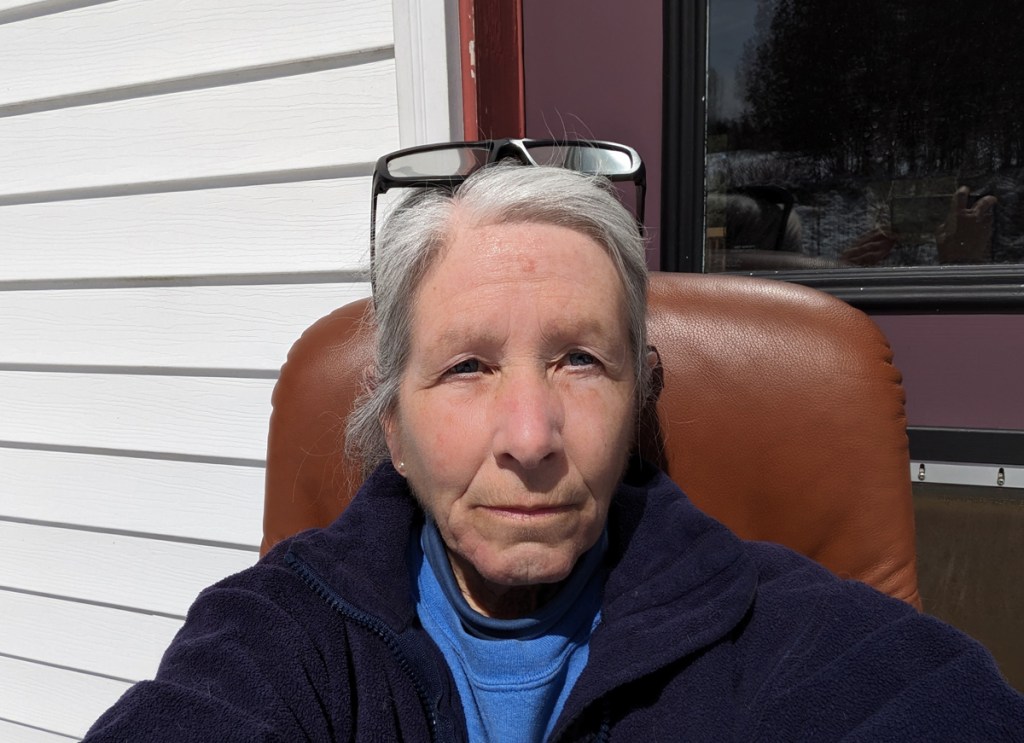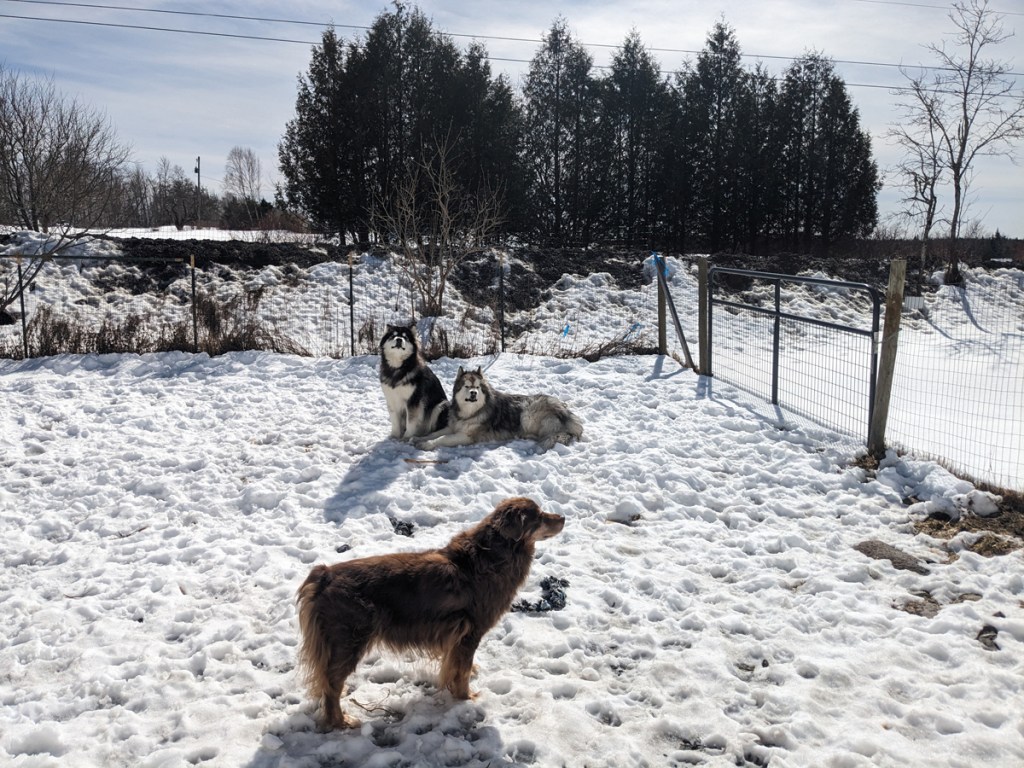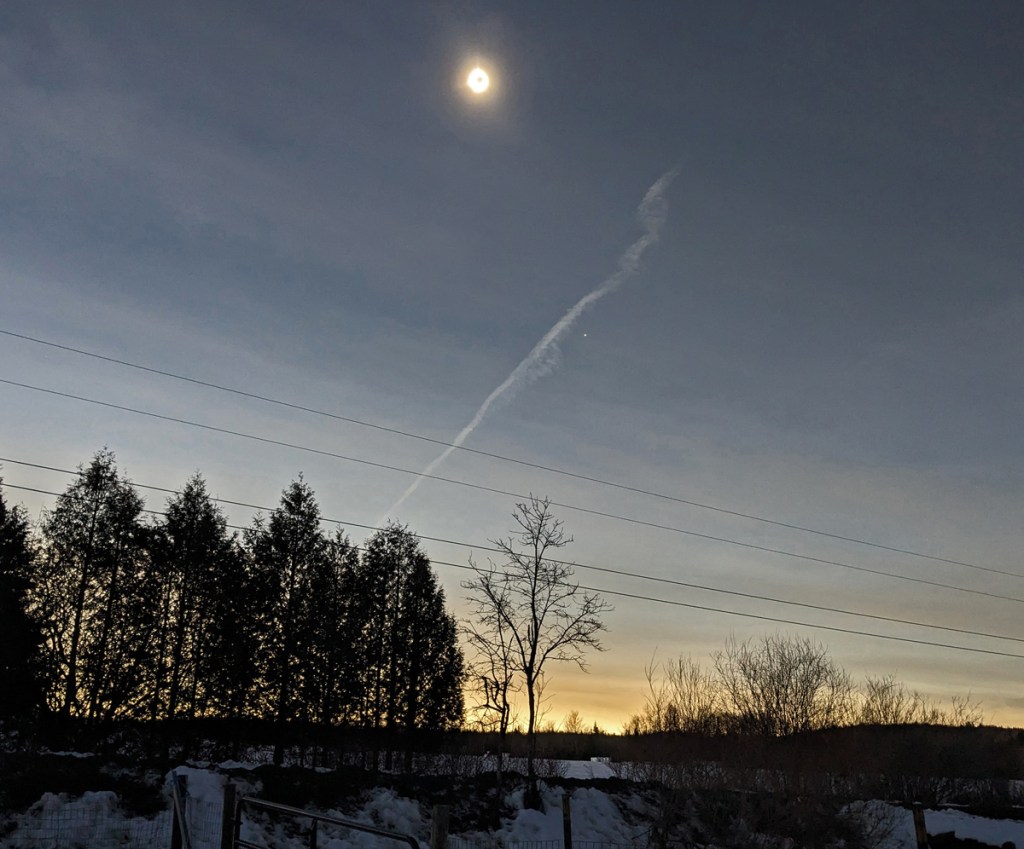For months, I knew the total solar eclipse was coming. Searching for maps of the predicted path of totality across the US, I was pleased to see I live directly under it.
The universe was affording me a second chance to see what all the hoopla was about.
***
On August 21, 2017, a total solar eclipse cast its shadow across the middle of the US. Starting in Oregon and crossing central Idaho, the shadow continued moving southeast, leaving the US at South Carolina.
I was living in Idaho then. Maps showed I lived a few miles outside the path of totality. To be directly under the path, I would need to drive 50-100 miles. I was planning on doing that until all the dire warnings about crowds and traffic started appearing on the news. The introverted me shuddered at the thought of being around sizeable crowds of excited people. And with a single, mostly two-lane highway between me and where I needed to go, I stayed home to see what I could. To be honest, seeing a solar eclipse in person has never been a “bucket list” item for me.
Some friends were aghast at my decision to stay home and miss totality. They planned to drive a significant distance from their home in Utah to view the “once in a lifetime” event.
I just couldn’t jump on that train. While I love a clear, dark night sky, stars sparkling brightly and sometimes shooting by impossibly fast, satellites meandering, I’ve never been obsessed with things celestial. My sentiments are more earthbound.
The 2017 total eclipse experience for me from my Idaho home? Nothing much. A slice of sun obscuring by the moon, a slight dimming of daylight, an almost imperceptible drop in temperature. The entire experience was a complete nothing-burger.
***
I ordered eclipse glasses in late January, even though predictions were for an 80% chance of cloud cover over my part of Vermont.
When I saw friends on Facebook posting about traveling to see the eclipse, trying to choose where to go, I offered to let them crash here. Given the typical April weather in Vermont, though, I didn’t take offense when no one took me up on the offer.
On March 23rd, roughly a foot of snow fell during a harsh, late-winter storm. Eventually, most of it melted off as daytime temps slowly rose toward spring levels. Then, on April 4-5, another storm arrived, dumping almost 18 inches of new snow. For several days, if it wasn’t snowing, the skies were the color of pewter, threatening more snow or rain.
Then, true to predictions, on April 7th, the skies cleared. NASA and local forecasters were saying the Northeast Kingdom in Vermont (basically, the northeast portion of the state) was set to be one of the best viewing locations in the country. The state expected hordes of visitors, especially those who lived within a day’s drive, and warned of horrible traffic.
This eclipse, though, I didn’t need to leave home to observe. I was under the path of totality. On its edge, sure, but that only meant that I’d experience a slightly shorter time of total darkness.
April 8th dawned with nary a cloud in the sky. I took Conall and Chann for a walk in the neighbors’ fields that morning, admiring the turns carved in the snow by parasail skiers over the weekend.

The eclipse started around 2:15 pm, with totality around 3:30 pm. The temperature rose to the mid-50s, a welcome surprise. I dragged a comfy chair out onto my front steps, grabbed the glasses I wear when driving and my eclipse glasses, and joined the boys in my yard to watch the show.

I took notes.
2:30 pm: the moon is crossing the sun at lower right.
2:45 pm: about ¼ of the sun is obscured by the moon; the edge of the moon seems to undulate against the bright sun, as if tossed in a wind (which is blowing here, thus the analogy). I can hear neighbors to the east, entire extended family visiting, children laughing, adults urging them to look. There’s no birdsong; the few that have arrived sing only at sunrise and sunset this early in the year.

3:00 pm: high, wispy clouds are blowing in from the west but don’t obscure my view. The moon is now covering ½ of the sun. Wind is picking up, gusting. It feels colder. Taking off my eclipse glasses and looking around me, everything appears duller. The ground is covered in snow so there’s not much color anyway, just the dark green of pine trees and the brown of bare deciduous tree limbs, but somehow, it’s all duller. The woods across the field appear darker, more shadowed. Snow looks gray rather than bright white. Even the side of my white house is dull.

3:10 pm: the sun is now a crescent. The moon dances against it, undulating, “Too hot!” it seems to say, its edges burning. Wind calming, more thin clouds moving in. The sky is a deep blue, except to the east. Overall, daylight is dimming slightly.
3:15 pm: hard to find the sliver of sun in the broad sky while wearing eclipse glasses; almost at the point of totality.
3:20 pm: a tiny sliver of sun now, but around me, still pretty light out. Snow becomes an even duller color of gray. No sparkle. I hear lots of airplane traffic overhead, low, civil aviation; unusual. The moon no longer undulates against the sliver of sun. Colder; almost get up to go inside and find a hat and gloves, but don’t want to miss anything. Conall howls at the neighbors, who are starting to whoop and holler.
3:25 pm: wearing eclipse glasses, all I see of the sun is a bright yellow line at the upper left/top; the rest is a black ball, the moon. Taking off the eclipse glasses, the surrounding light is weird, as if I’m wearing sunglasses that turn everything gray, washing out all color. The sky to the west appears dark.
3:26 pm: totality. Taking off my eclipse glasses, I stare directly at the moon and see a yellow/white brightness surrounding it with a bulge of warm yellow sunlight at the lower bottom edge. I spot a bright star to the east, below the sun/moon, next to a contrail blown apart by the wind; I couldn’t see it with eclipse glasses on. Grabbing my phone, I take photos, despite knowing it can’t get a good pic of the actual eclipse without special filters. I look at my dogs in the yard: no reaction from them. The neighbors are excited. “Look at that! Look!” I hear the adult urging the children. Someone nearby shoots a rifle; Conall jumps through the dog door into the safety of the house. [It’s moments like these, when the natural world should be more than enough, that I despise gun people and their way of celebrating.]

3:28 pm: the sun begins its slow appearance from behind the moon. Totality lasted just over two minutes. I put my eclipse glasses back on and take one last look as the sun and moon disengage.
Having seen the phases leading to totality, I don’t feel the need to see the rest. The dogs and I go inside. I upload my photos, see what I captured.
***
According to the federal census, Vermont has roughly 647,000 residents. It’s a sparsely populated state (which was a large part of its appeal for me).
A statewide online news source estimated that 160,000 people drove to Vermont to view the eclipse in 60,000 cars. A population increase of 25 percent. Others arrived by airplane and train. In fact, Vermont airports reported 248 total landings on April 8th, a record. There was a historic number of private airplane landings, with a significant number flying to small airports in the Northeast Kingdom. Departures started right after the eclipse, with a rate of two per minute within the first half hour after totality. No wonder I heard so many small airplanes.
Vehicle traffic was a nightmare that afternoon and evening. Visitors were stuck on highways for hours. Vermont’s highways and byways can’t handle such a sudden influx of traffic.
It’s the very scenario that kept me home during the 2017 eclipse. I’m pleased that I got to see it from the comfort of my home.
***
Those traffic woes beg the question: why are total solar eclipses so enticing to so many willing to travel long distances and spend significant time and money to see one?
For some, I imagine there’s a spiritual element. Perhaps they feel something awe-inspiring during an eclipse that’s akin to a religious experience, or confirms their religious beliefs.
For those enamored of the stars and planets, an eclipse is a way to observe firsthand, without a telescope, a celestial even rarely seen from any single location on earth. (If one’s willing to travel, it’s possible to see several total solar eclipses over the course of a lifetime.)
For the vast majority, though, I think it’s FOMO, or fear of missing out. The run up to an eclipse starts at least a year in advance, and anyone paying attention—to the news and especially on social media—feels the fool if they pass on the opportunity to see one.
Imagine reading this sort of thing, over and over, on the lead up to an eclipse:
For those who choose to experience this eclipse outside the path, a partial eclipse is all they will see. Even if the sun is 99.9% eclipsed for these observers, they will not experience the full, jaw-dropping, knee-buckling, emotionally-overloading, completely overwhelming spectacle that is totality.
For those outside the path, there is no dramatic moment of totality, no dance of Baily’s Beads around the edge of the moon’s disk, no intense darkening of the skies, no stars and planets suddenly revealing themselves against an impossible twilight, no corona flashing into view (the otherworldly beauty of which makes even veteran total eclipse observers gasp in amazement), and no primordial fear which sinks ever so slightly even the modern heart. There is no pitch-blackened disk of the sun, no discernable temperature drop, no impossible nighttime during the day, no scintillating chromosphere or glorious prominences, no 360-degree sunset effect around the horizon, no uncontrollable shouts of emotional overload from the assembled crowd, and no lingering post-eclipse sensation of certainty that you have just done one of the coolest things you’ll ever do in your life.
A partial eclipse is interesting but forgettable, while a total eclipse is a memorable, life-changing event which burns itself into memory – and never fades.
From Eclipse2024.org
That certainly makes one think they’d better view a total solar eclipse if humanly possible, right?
Perhaps for some, the experience is all that. For me, it simply wasn’t that extraordinary. Interesting, yes, but not life-altering, and far from the coolest thing I’ll ever do in my life. I’ve already seen and done cooler things.
And that’s the rub. The experiences considered valuable, even amazing, vary drastically from person to person. For some, a total solar eclipse is top of list. For others, like me, it was fun to see observe it right over my house, but I’d never travel to view another one.
Everyone’s jam is a unique flavor. And that’s okay. There are plenty of extraordinary experiences to go around, both here on earth and out there among the stars.
Feature photo: map showing both the 2017 and 2024 eclipse paths over the US. From nationaleclipse.org.


We lost about 92% of the sun in Gettysburg. I thought it was pretty cool and enjoyed experiencing it with my coworkers. Even though I assign an unreasonable amount of spiritual value to astronomical oddities, I had no desire to travel for the total eclipse, After reading the traffic horror stories afterwards, I KNOW I’ll never travel for one in the future. My daughter walked around the Lake Champlain waterfront park in Burlington that morning. She reported bus after bus after bus pulling up, dropping off a load of passengers and pulling away. She said THAT was was a pretty shocking sight.
LikeLiked by 1 person
Jeff, your comment makes me realize that, prior to social media, the experience of seeing a total eclipse was likely quieter and much more personal, or maybe shared with small groups. Now, it’s a crowd event, like your daughter saw. Great for extroverts, at least!
LikeLike
I’m glad you got to experience it without all the travelling and the hype!
LikeLiked by 1 person
Me, too. Certainly worth experiencing when easy and without all the social negatives.
LikeLiked by 1 person
Even with our mobile lifestyle we made no plans to be in the path of totality. We knew it would be a madhouse. Our plans at the time would have had us way out of the path. However, due to unforeseen circumstances we found ourselves back in Texas at my parents farm which was in the 98% totality path. That was good enough for us and it was neat to see but I wasn’t going to go out among the throngs for that other 2%.
LikeLiked by 1 person
FOMO is a huge thing with many people. I don’t have that gene at all. I think some people also just like to go to a crowd. That I certainly don’t get. 🤣
LikeLiked by 1 person
No FOMO here, either, or affinity for crowds. Quite the opposite! Which is why I was so happy to experience the eclipse with my dogs, at home, only the neighbors’ voices intruding.
LikeLiked by 1 person
I’m glad you got to see it without having to fight the crowds. The thing I remember the most when one happened here was the drop in temperature. A cool experience, literally!
LikeLiked by 1 person